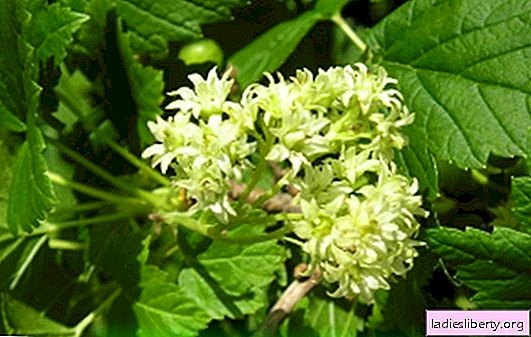
There is no healthier berry than currants.
However, it is sometimes very difficult to grow a healthy bush and get a good harvest.
Cultivation is complicated by currant diseases and pests.
One of these diseases, which completely destroys the crop, is terry (reversion).
Terry - This is a dangerous viral disease of the berry, which is more common on blackcurrant. It affects almost the entire bush. The disease causes the degeneration of currants to a wild state. Sometimes the disease subsides, but returns again. Hence another name for the disease - recurrent disease.
What is the terry of blackcurrant
The causative agent of this disease is a virus that travels through the vessels of the shrub and infects it entirely. You can detect the disease in early spring, when the first leaves bloom. Currant can get the terry virus in any climatic zone.
Signs of currant disease
When examining a bush with a vein, you need to pay attention to the following signs of the disease:
• The apical leaves of the shoots have become three-lobed, rough and dark green - this is the first sign of degeneration of currants. A healthy bush has five-pronged leaves.
• The leaves are elongated, without small veins.
• A healthy leaf of currant has a characteristic odor; plants damaged by terry lose this property. Leaves are odorless.

If it was not possible to determine the disease in early spring, then during flowering the damaged plant stands out from the general plantings. The reliability of the diagnosis of the virus is 100%.
• The structure of the flower changes in the affected plant. The flowers are reborn, become terry and separate.
• Flower brushes are extended and get a lilac shade.

Such bushes do not form ovaries and become barren. There is a partial defeat of currants with terry. Such plants have healthy shoots, only the tops of the stems are damaged. In diseased plants, flowering is late, small berries are formed.
How terry spreads in currants
The spread of the disease is a kidney tick that hibernates in the currant buds. In spring, the pest switches to healthy shoots, infection occurs at the time of tick feeding. The infection penetrates the plant tissue.
Currant infection occurs in those areas where the plants are not damaged by a tick. The carriers of the virus are other pests of currant:
• aphids;
• spider mites;
• bugs.
A viral disease persists throughout the season and hibernates in the plant itself. Therefore, the source of infection is the landing itself. The infection enters the body of the tick and is transmitted to other plants.
Often infection occurs during vaccination of a diseased cuttings on a healthy plant. When pruning, when an intermediate disinfection of a garden tool has not been carried out.
Important! With a bush of currant affected by the terry, cuttings do not cut!
What is dangerous terry on blackcurrant
Terryness is a very insidious disease, which often stops its development, thereby masking itself.
Affected plants lose their productivity partially or completely. A viral disease develops for a long time, gradually. Productivity does not fall immediately.
If the disease entered the garden through a new planting material, then such plants will not bear fruit, they will be infertile.
Important! The source of infection is the affected currant bushes. All infected plants must be removed.
In this situation, do not hesitate, you need to act bolder and replace the planting material with healthy bushes.
What to do if currants are infected with terry
Unfortunately, the disease is not treated, all diseased bushes need to be uprooted. For the future, we can only advise preventive measures:
1. Planting on the site you need only healthy planting material. All seedlings should be carefully examined for pests.
2. You need to plant disease-resistant varieties.
3. The gardener should regularly spray the plants with immunostimulating drugs.
4. Time to destroy all pests on the site.
5. Carry out preventive measures to control pests.
6. Remove all trash under the bushes.
The most resistant to terry are varieties with early awakening of the kidneys, in which the development of apical shoots ceases at the time of mass destruction. These varieties include: Memory of Michurin, Zhelannaya, Kent, News.
How to deal with a kidney tick
In spring, you need to inspect the bush well and remove all swollen buds in which the pest hibernates. If the shoot is severely affected, then it must be removed entirely. All cut branches are burned.

Against the tick, several chemical treatments are carried out.
• The first treatment begins in the spring, at the time of tick migration.
• The second is held in the first half of summer.
Resettlement of ticks in young buds occurs before flowering, then it is necessary to carry out treatment with drugs. It is good for these purposes to use biological preparations:
• Lepidocyte;
• Bitoxidacillin.
With severe infection, when no methods of control help, you can resort to chemicals.
• Fufanon;
• Acarin;
• Fitoverm.
If necessary, re-processing is carried out after full harvest, when the pest is actively propagating.
Fertilizers to enhance plant immunity
Growing currants on the site, you need to monitor its health. Cuttings only those plants on which there were no signs of terry for the past 4 years.
Fertilizing will help increase the plant's resistance to the virus. Proper application of fertilizers allows you to grow healthy seedlings, which will give a good harvest.
For top dressing, phosphorus-potassium fertilizers are used. In addition to root dressing, it is good to carry out foliar spraying with the following solutions:
• Molybdenum;
• Manganese;
• Bora.
Increase the dose of nitrogen fertilizers in nutrient mixtures is not worth it. This gives the exact opposite result. Plants, on the contrary, become vulnerable to the terry virus. After harvesting, the bush can be treated with colloidal sulfur.
Useful Tips
- Planting new currant bushes instead of damaged ones to their original place is possible only after five years.
- At the site of the former planting, you can break the beds using organic matter. Terry virus is not a threat to other cultures. The fruits can be harvested and eaten.
- Inspect the plantings as often as possible to prevent infection of healthy bushes. Timely removal of terry affected plants will positively affect crop yields.
- Timely sanitary cleaning allows you to monitor the condition of the plant. The probability of defeat is reduced several times.
- Regular watering helps regulate the moisture around the shrub. A too humid environment attracts most pests.
Digging the soil around the shrub and harvesting weeds will help reduce the risk of damage.











